
Elsie’s Peak Hike

This peak, at 303 m, is only 3 m higher then the Eiffel Tower in Paris, but what it lacks in height is more than made up for with breathtaking views of the Cape Peninsula. It is an easy walk up with no technical difficulties. No one knows who the first
person to climb it was, but the first recorded climb was by G F Travers-Jackson at the beginning of the 1900s when he climbed Outlook Ridge.The origin of the name‘Elsie’s Peak’ is still a mystery; it could be named after Elze River in the Glencairn valley or after a ship, the Esselstein, which stopped over in Simon’sTown Bay in 1671.

Cape Glass Factory

The ruins of a short-lived venture of the Cape Glass Company Ltd can be visited in Glencairn Heights, right in the midst of suburbia. The glass was extracted from the vast sand dunes which covered nearly the whole of the valley. Ohlsson’s Cape Breweries had a large stake in this business but, over a short period of time, it was not profitable and closed only 3 years later in 1905. The one accomplishment was it was a technological
pioneer being among the first glass factories in the world established to manufacture bottles solely by machine.

Glencairn Private Museum

The museum belongs to retired Rear Admiral Arne Söderlund, who has been collecting all manner of paraphernalia since the late 1950s. As the False Bay Echo said, “Military uniforms, moustache-curling tong warmers, perfume bottles, hundreds of airsick bags, antique tins and powder compacts – you name it and the Den of Antiquity – Junk and Disorderly, a private museum in Glencairn, has it all”. Information: call Admiral Söderlund on 021 786 3283 or email angel45@iafrica.com. Visits by appointment only. Price: Donations go to the South African Bone Marrow Registry.

Emily Roose Grave

Without fanfare, Emily Roose, the nanny of Prince Phillip, Queen Elizabeth’s husband, died at Simon’s Town and is buried in the Dido Valley Cemetery. Besides having been a loyal and loving nanny to Phillip through his younger years, she had also delivered Prince Phillip on a dining room table back in Greece in 1921. Her grave stone was paid for by the Greek Royal Family.

The SS Clan Stuart

On 21 November 1914,The SS Clan Stuart, a 3500 ton British turret steamer, carrying a cargo of coal, ran aground after dragging its anchor in a south easterly gale off Mackerel Beach. Several efforts were made to refloat the ship over a period of 4 months but without success. The ship’s engine block still breaks the surface. The wreck now sits at a depth of 7m to 9m and has become a favourite for training diving and night dives.


Klein Vishoek
In 1809, Andries Albertus Bruyns applied for this piece of land next to the Lower North Battery for his fishing business. Lord Charles Somerset granted his request in 1823 and Bruyn’s family ran a successful fishing business until the end of the 19th century. Thereafter, the house was bought by Dirk van Breda and then occupied by local fishing families until 1959. It was subsequently owned by Marine Oil Refineries, a Dr Oberholzer (1965), the Chaplin family and, finally, became S.A. Navy property in 1982.


Glencairn Quarry
The sandstone that was cut out of this quarry was needed for building the Naval Dockyard in Simon’s Town. All the stone was loaded onto a barge and transported across the bay.This was owned by the Divisional Council and was opened in 1898. It was closed for a brief period between 1914 and 1918 during the Great War. The quarry was taken over by Strong & Moore for a number of years before it was closed permanently in 1978. Today, the old quarry has a new lease on life as a shooting range with False Bay Sport Shooting Club.

Harbour Bay Mall

The first shopping mall in Simon’s Town was opened in 2018. The 14 800m2 mixed use development includes a shopping mall with mixed residential living, a private same-day surgical facility, a boutique-style, fully equipped gym with various studio classes offering short and long-term contracts and retail. It was built on the site of the old Marine Oil Refinery in Dido Valley which was demolished in 2005.

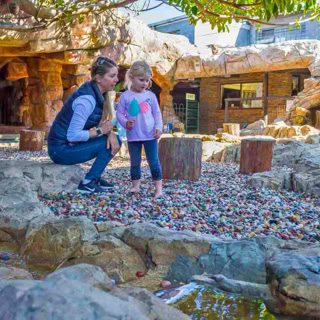
Scratch Patch
Gemstones for Africa! Lie down in a carpet of gemstones and buy the ones you choose - this is a treasure trove for kids and a lot of fun. For the adults, many different gemstone products are for sale. The stones are tumble-polished on site in the world’s biggest gemstone factory that processes some 150 varieties of stones from all around the world.


Glencairn Beach
This beautiful little beach is often overlooked, which is a good thing for those who like their own space.There is a tidal pool for the little ones and it is one of the best spots for whale-watching in season. It was on this beach in 1968 that a coloured man, 24 year old Clive Haupt, collapsed and died: his heart was used (in the third heart transplant in the world) for a white recipient, which caused much consternation in then Apartheid South Africa. Behind this beach, on the other side of the road, a walk around the vlei on well- marked paths will reveal abundant bird life.

Glencairn Mill

The ruins of the old Glencairn Mill are found within the South African navy sports ground which used to be part of the Welcome Cottage Farm in 1812. This water mill was probably built around 1820 by J. H. Brand. Welcome Farm was transferred to Thomas Brownrigg Wools, a merchant, in 1828. The mill was in operation until at least 1842, when Welcome Farm was auctioned, along with a mill and bakery, and bought by Frances Bateman Pinney who took up vegetable farming.

Lower North Battery

This battery sits on the original site of the Zoutman Battery, built in 1793 under the VOC. Two years later, the Dutch abandoned the battery after spiking their guns before the Battle of Muizenberg. The British took control of the battery and renamed it the North Battery. Upgrades to the battery started from 1806 till 1962 when the battery became the Gunnery School’s firing range which saw the addition of later naval guns. This battery has the distinction of being the oldest fortification in South Africa which is still armed.

Scala Battery

Three 9.2 inch guns were installed as part of the Scala Battery during WW2 to defend Simon’s Town. These guns were never fired in anger but were used for training purposes. In 1947, they were used to to scuttle the SATS General Botha (formerly HMS Thames) which was moored some 9 nautical miles out in the middle of False Bay.

Middle North Battery

A 9 inch gun rifled muzzle loading gun, known as “Betsy”, was designed in 1865 as a broadside gun for ironclad ships and harbour seafront defence. Only 190 were made. The gun was last fired in 1903. This gun was first mounted in Halifax, Nova Scotia until 1878, then in Bermuda until 1881 and then in Sheerness, England until 1885. It was lastly mounted at Middle North Battery Simon’s Town in 1896. This gun barrel is also rifled with 6 grooves and is the only gun manufactured with this number of grooves. In 2011 the Cannon Association Of South Africa refurbished and fired it for the first time in was fired in 108 years.


Red Hill Pass
This pass is 7.6 km long with over 30 bends, corners and curves with spectacular views all the way to the top. The old track up the hill, from the 1800s, is one of the older passes on the Cape Peninsula and, for many years, was the only route to Cape Point and the southern reaches of the Peninsula. The older track was upgraded including a reroute towards the Scala Battery in 1932.


Redhill Village Ruins
Redhill was once a village, home to more than 70 predominantly mixed race families. Today, these homes lie in ruins. One reason is that families removed doors and windows when they left to start an unwanted new life on the Cape Flats. They were forcefully removed between 1965 and 1970 by the Apartheid government under the Group Areas Act but, in this case, an excuse of a new dam to be built was the purported reason. The dam never materialised. In 1989, previous residents were paid R14,000.00 in compensation for their suffering. Today, this area is managed by SANParks.

Kleinplaas Dam

This earth wall dam was built in 1964-67 to supply water to Simon’s Town. The wall was extended in 1970 with a present capacity of 1 300 Ml. It was built on the eastern site of the Kleinplaas farm, hence the name, ‘small farm dam’. This was the main source of water to Simon’s Town until the early 1980s when the town was connected to Cape Town’s major water sources. Today, this is a well known hiking area with a relatively flat network of trails. Starting in the 1990s, this area has become one of the premier bouldering (climbing) sites on the Cape Peninsula.


Roman Rock Lighthouse
The Roman Rock Lighthouse, the fifth oldest in South Africa, was built between 1857-1867 and was the only lighthouse in the southern hemisphere to be built on an offshore single rock. Today, it is still the only lighthouse in South Africa built on a single rock. Granite blocks were cut out from the rocks on Seaforth Beach for the base of the cast iron segmented upper structure. The lighthouse was electrified in 1992.

Simon’s Town Railway Station

This station was built before the railway line reached Simon’s Town and was opened by the Premier of the Cape at the time, Cecil John Rhodes, who rode in the first train which arrived in a bunting-bedecked Simon’s Town. There was a parade, free train rides for the children and a grand luncheon at the British Hotel for all the dignitaries.The final extension of the railway line from Kalk Bay to Simon’s Town started in 1889 and was completed and opened on 1 December 1890. The line was electrified with overhead catenary in 1928.


Long Beach
Long Beach is popular with kayakers, photographers and scuba divers. It is right next to the Simon’s Town railway station and and has ample parking available. It is perfect for beginner divers and a variety of fish not commonly found in the region have been sighted here.
It may occasionally be closed for diving when foreign warships are in the Simon's Town naval base.

Admiralty House

This site was first built on by Antoni Visser in 1740. He was a former Dutch soldier who became the unofficial representative of the VOC at Simon’s Town. By 1760, the rough layout of Admiralty House was in place, making one of the oldest building in Simon’s Town. Alterations occurred in 1853 and 1875. It was the residence of the Royal Navy’s Simon’s Town Commander-in-Chief from 1814 to 1957. Famous people who have stayed or visited Admiralty House are HM King George VI, Prince Alfred, second son of Queen Victoria, Louis Napoleon, Prince Imperial of France, Rudyard Kipling, Sir Winston Churchill and Robert Scott from the ill-fated expedition to reach the South Pole.

Studlands the Wine-House

This ‘Wijn Huys’, was built on the edge of Simon’s Town in 1797 by J.P. Eksteen as Admiral Elphinstone in 1795 noticed the existing liquor outlet was next to the main navy jetty and many seamen coming ashore never made it beyond this point. Studlands was declared a national monument in 1965 but now has been reclassified as a provincial monument. It is likely the oldest existing Wine-House still standing in South Africa today.


St Francis of Assisi Parish Church
In 1837, this church (which had a rocky start as a result of the original church building collapsing in 1821 due to flooding) opened its doors. The church is named after Lady Frances Cole (governor’s wife of the Cape Colony) for her commitment and fundraising. It suffered another setback, losing 70% of their congregation because of the forced removal policy of the government.


The Residency Simon’s Town Museum
This museum was established in 1977 to showcase the local history and events that have shaped Simon’sTown from 100 000 years ago, through the Colonial period until recent times. The building that houses the museum, The Residency, was built in 1777 as the winter residence for the Dutch East India Company governor at the Cape.

SA Navy Museum

This interesting museum is full of naval artefacts and exhibitions that tell the story of the South African Navy, from vintage navigational and divers’ equipment, model ships and submarines, uniforms and medals to weaponry. The museum is housed in the historical Dockyard Magazine and Storehouse of 1743 which was enlarged in 1810 to become the three-storey building we see today.


Able Seaman Just Nuisance’ Grave
Just Nuisance was the only dog ever to be officially enlisted in the Royal Navy. He was a Great Dane that, between 1939 and 1944, served at HMS Afrikander, a Royal Navy shore establishment in Simon’s Town, He died in 1944 at the age of seven years and was buried with full military honours at Klaver Camp,situated above Simon’sTown, where a simple granite headstone marks his grave. Despite being at war, a naval signal was sent announcing his death and burial to every Royal naval ship and establishment worldwide.

Signal School Steps

Starting in Barnard Street, you will find one of the longest well constructed staircases in South Africa, built to service the Signal School above on the Klaver Valley plateau. Estimated to have 340 steps with angled ramp walkways, this is a fitting hill walk with the reward of visiting Just Nuisance’s grave at the top.

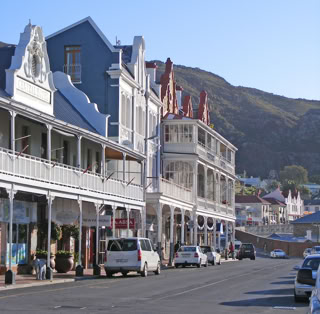
St George’s Street
This part of the road through Simon’s Town was referred to as the Main Street until 1899 when the Simon’s Town Council gave names and sign plates to all the streets of the town. The street was named after the first Anglican Church in South Africa which was in Simon’s Town. This street today is home to many vernacular buildings and is one of the few remaining streets in South Africa showcasing a bygone era. Other important historical locations on this street are Jubilee Square, the Wester Dockyard gates and the old jetty.


Submarine Museum
The Daphné-class submarine, SAS Johanna van der Merwe, was commissioned in 1971. She was renamed SAS Assegaai in 1999. She was decommissioned in 2003 and later became a floating museum from 2011 until 2015. In 2024, she was moved to a new permanent land-based location next to the NSRI Station at Cole Point. At 58m long and over 700 tons, the move of the submarine from the dockyard to the site was a unique achievement. This museum was opened to visitors in December 2024 and is the only submarine museum open to the public in Africa.


Warrior Toy Museum
This quaint little museum is the place for kids and adults who are young at heart. On permanent display are 4000 model cars, 500 dolls and teddy bears, miniature dolls houses, two fully operating railroads, lead soldiers, Meccano, ships and more. Percy van Zyl, the curator of the museum, has created a heaven for collectors of toy cars, buses, airplanes, trucks and lead soldiers.

Jubilee Square

Before 1880, this square was known as Market Square. The square was renamed to commemorate the Silver Jubilee of George V in 1935. Just Nuisance was immortalised in bronze by Jean Doyle in 1985 and the statue was erected on Jubilee Square as part of a major restoration project that took place a year later.


Sts. Simon and Jude Catholic Church
Two Spanish brothers, the Delcarmes from South America, married an Irish and a German woman respectively. Their descendants were so numerous that they formed the basis of the congregation. This church is named after Simon the ‘Canaanite’ in the Gospels. The foundation stone of this church was laid in 1885.

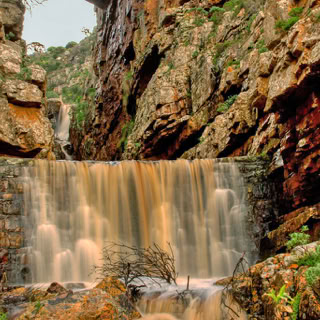
Admiral’s Kloof
High up in the gorge above Simon’s Town is one of the best short walks on the Cape Peninsula:15 to 20 minutes of easy walking will get you from your car to the end of the kloof. The highlights are spectacular views, two waterfalls, an old dam from yesteryear and one of the best examples of a 200-300 million-year-old thrust fault (seen across the valley on the opposite rock face).

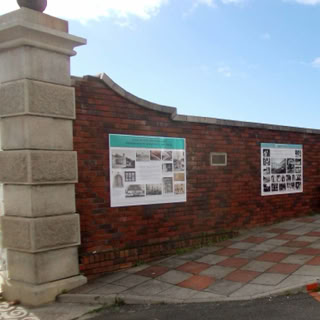
Wall of Memory
This project by the Simon's Town Historical Society was installed on St George’s Street to celebrate and commemorate Simon's Town’s rich history and culture. It focuses on the naval presence, fishing industry, the Group Areas Act including forced removals of non-whites and the Muslim community.


Simon’s Town Jetty
In 1886, the first public jetty in Simon’s Town was constructed using light timber. In 1905, this jetty was replaced using heavier jarrah timber and, in 1921, reinforced concrete was used as a replacement.This jetty is one of the oldest structures of its type still in use today.


Charles Darwin Bust
A bronze bust of a young Charles Darwin, as he looked when he visited Simon’s Town in 1836, was unveiled in April 2025 on Simon’s Town Jetty. The bust was sculpted by Johan Steyn and the project was spearheaded by Professor Mike Bruton.He initiated the project to commemorate Darwin's visit to the Cape Colony and to highlight the significance of that visit in the development of his theory of evolution. The event was attended by Darwin’s great-great-grandson, Andrew Darwin.


The Nooral Islamic Mosque
The Nooral Islamic Mosque in Thomas Street was originally a private house used as a place for prayer as far back as 1888. In 1904, a wooden minaret was added to the house. In 1911, the Moslem community bought the house.The old building was replaced in 1924 and reopened in 1926.

Amlay House

This small museum in the Amlay’s house, built in 1858, is a window into the rich Muslim culture that existed in Simon's Town from the Dutch East India Company period until the forced removals of more than 7000 people under the Group Areas Act in 1967. This is very much a human collection of the family that lived here and friends and people from the community.
Selborne Graving Dock


The dock is named after William Palmer, 2nd Earl of Selborne, the High Commissioner for Southern Africa at the time of construction. The tender for the construction of the Selborne Graving Dock was awarded to Sir John Jackson Ltd. The foundation stone was laid in 1906 and the dry dock was opened in1910.The Dockyard was handed over to South Africa in 1957 as part of the Simon’s Town Agreement.

Aerial Ropeway

The first aerial ropeway was built in 1904 to assist in the construction of the sanatorium above Simon’s Town and to transport patients. Later it was also used for taking supplies up to the firing range on the Klaver Valley plateau. The original wooden ropeway was replaced by 17 pylon steel structures in 1913. The ropeway starts from between the Old Sail Loft and Clock Tower, passes the Engine-House at the Royal Naval Hospital and ends at the sanatorium. In 1927, the ropeway stopped operations and, in 1934, the cables were removed.


This unique Corsican circular designed fort was adopted by the British and used during the Napoleonic Wars. Three were constructed in South Africa. The Simon’s Town Martello Tower was built under the command of Major General James Craig in 1796 and was the first building erected after the 1st British occupation. In addition, it could be the oldest surviving Corsican-pattern tower in the world; its only rival in age is likely the Prince of Wales Tower in Halifax, Nova Scotia.
Martello Tower


Seaforth Beach
This beach is the free version of Boulders beach and now it seems as if it also has some resident penguins. The beach is 600 m wide, flanked by granite boulders with grass lawns which makes it a perfect family beach. Back in the early 1800s, this place would not have been a good choice for a family outing as it was the first whaling station in South Africa under the British occupation. Its smelly boiling blubber was its downfall and the operation was moved to Kalk Bay.


Simon’s Town Harbour
Simon's Town's harbour history is deeply intertwined with maritime and naval activities. Initially serving as a safe anchorage for the Dutch East India Company in the 1740s, it later became the British Royal Navy's South Atlantic headquarters. Today, it remains South Africa's principal naval base.

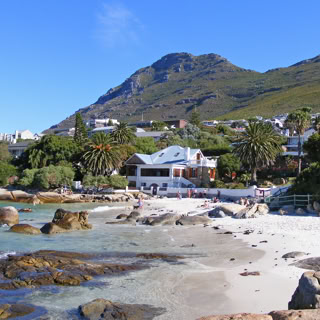
Water’s Edge Beach
Water’s Edge Beach is thought of as a local secret. It lies tucked away between Seaforth and Boulders beaches. It is a wonderful haven for children, particularly due to the rock pools, and is also ideal for swimming and sunbathing. Behind the beach is the beautiful Water’s Edge Cottage which was designed by Sir Herbert Baker in 1903.
Simons Town - an iconic historical town.
Notes
Simon’s Town Visitor Information Centre
Simon’s Town Visitor Information Centre is run by a group of volunteers who are available to give you the best advice, maps and printed literature when visiting Simon’s Town.They are at Jubilee Square and can be contacted on 021 786 4737.
All information is given in good faith but, as times and facilities may change, the author and publisher cannot be held responsible for any inaccuracies. Citations available on request. Many thanks to Rear Admiral Arne Söderlund (Ret) for his valuable input and to the Simon's Town Historical Society for going through the guide to ensure that the information is as accurate as possible and for allowing us to use the old Simon’s Town Coat of Arms.
©️ Richard Smith • Gateway Guides Edition 1 • 2025


Boulders Beach
One of the best places to see the African penguin up close and in its natural habitat. Well made viewing platforms and boardwalks enhance this experience and are great for wheelchair-bound people. This is also one of the popular family beaches, out of the wind and with many little spots you can have to yourself. There is excellent swimming and diving.


This is one of the oldest buildings in Cape Town, built in 1679 as the slave lodge of the Dutch East India Company. Through its long history it has served many purposes. Location: Corner Adderley and Wale Streets Information: www.iziko.org.za/museums/slave-lodge Hours: Monday to Saturday: 10am to 5pm Closed Sundays,Workers’ Day and Christmas Day Price: small fee.
Windmill Beach


Simon’s Town Country Club
Most people know this short 9 hole links golf course as one of the oldest golf courses in South Africa. It was founded in 1913, but many do not know that it was once an Anglo-Boer War prison camp for prisoners awaiting shipment from the Simon’s Town naval base to Ceylon. Most of the 4000 Boer prisoners here were taken at the Battle of Paardeberg. In 1915, the Cape Coloured Corps was formed on this site which was known as Bellevue.


Dolerite Dike Froggy Pond
This is one of the finest and most accessible examples of a 130-million-year-old dolerite dyke (like volcanic rock) that has intruded into the much older (540 million years) granite. Just next to this, on the sea side of the rocks, you will notice what seems like a low wall running across the rocks: this is another intrusion but, this time, made up of a slightly younger granite that pushed up through cracks. These low walls or ridges are known as Aplites.

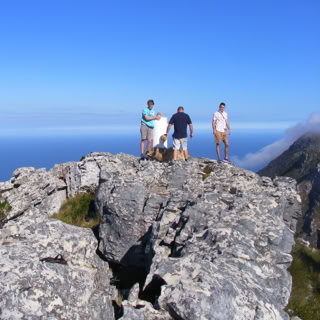
Swartkop Hike
This hike to the top of Swartkop Peak at 678 m, is one of the best hikes in the Cape Peninsula with 360 degree breathtaking views over False Bay.The hike starts on the western corner of Jan Smuts Drive in Seaforth.


Fisherman’s Beach
Fisherman's Beach is a rocky bay situated on Main Road. This pretty little cove, with its turquoise crystal clear water, is a safe and popular spot for swimming and diving. There is a grassy verge, perfect for sunbathing and picnicking. Limited parking keeps the crowds away and a quiet day can be enjoyed by both locals and tourists.
© Richard Smith
Citations available on request.